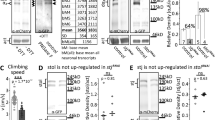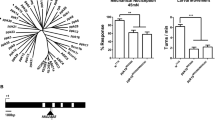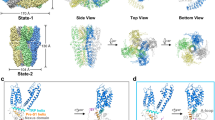Abstract
The gating of potassium ion channels has been shown to be dependent on voltage1 or Ca2+ ions2,3 or both4,5. A fast transient potassium current (sometimes denoted IA) is found in a wide variety of animals6–14. The Ca2+-sensitivity of this early outward current has been a matter of dispute as reports from different systems have indicated complete insensitivity6–8, marked sensitivity10–12 or only partial sensitivity13,14. It is possible that there are two distinct early outward current systems, one Ca2+-sensitive and the other not. Thus, the reports of partial Ca2+-sensitivity would indicate the presence of both systems in the membrane. I now report that in the adult Drosophila flight muscles, the transient outward current is also partially Ca2+-sensitive. The hypothesis that two separate currents are present is strengthened by the discovery that in several mutants of the X-linked Shaker locus (ShKS133, Sh102 and ShK0120; refs15–17) the Ca2+-independent component (IAci) is absent with only the Ca2+-dependent component (IAcd) remaining. Hence, the mutations seem to delete one of two separate current systems. An alternative hypothesis is that only one channel type is present that can be modified by mutation to be totally Ca2+-dependent.
This is a preview of subscription content, access via your institution
Access options
Subscribe to this journal
Receive 51 print issues and online access
$199.00 per year
only $3.90 per issue
Buy this article
- Purchase on Springer Link
- Instant access to full article PDF
Prices may be subject to local taxes which are calculated during checkout
Similar content being viewed by others
References
Hodgkin, A. L. & Huxley, A. F. J. Physiol., Lond. 116, 449–472 (1952).
Meech, R. W. A. Rev. Biophys. Bioengng 7, 1–8 (1978).
Gorman, A. L. F. & Hermann, A. J. Physiol., Lond. 296, 393–410 (1979).
Adams, P. R., Constanti, A., Brown, D. A. & Clark, R. B. Nature 296, 746–749 (1982).
Barrett, J. N., Magleby, K. L. & Pallotta, B. S. J. Physiol., Lond. 331, 211–230 (1982).
Hagiwara, S. & Saito, N. J. Physiol., Lond. 148, 161–171 (1959).
Connor, J. A. & Stevens, C. F. J. Physiol., Lond. 213, 21–30 (1971).
Neher, E. J. gen. Physiol. 58, 36–53 (1971).
Barrett, J. N. & Crill, W. E. Fedn Proc. 31, 305 (1972).
Siegelbum, S. A. & Tsien, R. W. J. Physiol., Lond. 299, 485–506 (1980).
Miledi, R. Proc. R. Soc. B215, 491–497 (1982).
Mounier, Y. & Vassort, G. J. Physiol., Lond. 251, 609–625 (1975).
Coraboeuf, E. & Carmeliet, E. Pflügers Arch. ges. Physiol, 392, 352–359 (1982).
MacDermott, A. B. & Weight, F. F. Nature 300, 185–188 (1982).
Jan, Y. N., Jan, L. Y. & Dennis, M. J. Proc. R. Soc. B198, 87–108 (1977).
Tanouye, M. A., Ferrus, A. & Fujita, S. C. Proc. natn. Acad. Sci. U.S.A. 78, 6548–6552 (1981).
Salkoff, L. & Wyman, R. Nature 293, 228–230 (1981).
Salkoff, L. & Wyman, R. Science 212, 461–463 (1981).
Salkoff, L. & Wyman, R. J. Physiol., Lond. (in the press).
Brehm, P. & Eckert, R. Science 202, 1203–1206 (1978).
Eckert, R., Tillotson, D. L. & Brehm, P. Fedn Proc. 40, 2226–2232 (1981).
Ashcroft, F. M. & Stanfield, P. R. J. Physiol., Lond. 323, 93–115 (1982).
Author information
Authors and Affiliations
Rights and permissions
About this article
Cite this article
Salkoff, L. Drosophila mutants reveal two components of fast outward current. Nature 302, 249–251 (1983). https://doi.org/10.1038/302249a0
Received:
Accepted:
Issue Date:
DOI: https://doi.org/10.1038/302249a0
This article is cited by
-
A rapidly inactivating Ca2+-dependent K+ current in pheochromocytoma cells (PC12) of the rat
Pfl�gers Archiv European Journal of Physiology (1990)
-
Electrogenic responses elicited by transmembrane depolarizing current in aerated body wall muscles ofDrosophila melanogaster larvae
Journal of Comparative Physiology A (1988)
-
A calcium-dependent potassium current is increased by a single-gene mutation inParamecium
The Journal of Membrane Biology (1987)
-
Two distinct calcium-activated potassium currents in larval muscle fibres ofDrosophila melanogaster
Pfl�gers Archiv European Journal of Physiology (1986)
-
The purification of ion channels from excitable cells
The Journal of Membrane Biology (1985)
Comments
By submitting a comment you agree to abide by our Terms and Community Guidelines. If you find something abusive or that does not comply with our terms or guidelines please flag it as inappropriate.



